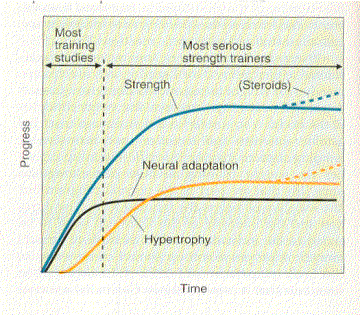Some people think Westside
The principle is embraced by Crossfit
Also discussed albeit briefly, in Taleb’s Antifragile
Sedentary makes you fragile, weak, and soft; exercise makes you robust; Westside is Antifragile.

There are no data on Westside proper, but there are on different periodization techniques – depending on how frequently you change between high weight low reps, low weight low reps, & low weight high reps. In Westside, Maximal Effort (high weight low reps) & Dynamic Effort (low weight low reps) are done every week, with some high weight high rep supporting exercises. But please see Westside for better descriptions of their protocol if you’re interested.
These studies are about Periodization
divide and conquer
Linear Periodization (LP) vs. Reverse Linear Periodization (RLP) vs. Daily Undulating Periodization (DUP) (Rhea et al., 2003)
This, like many of the other studies discussed below, controlled for volume & intensity as best they could. They were testing Periodization techniques, how how frequently you changed the volume & intensity.
In the Rhea study, everyone did 3 sets of leg extensions twice per week. Admittedly, this is a horrifically weak intervention, but it’s in intro into some of the different periodization protocols. And the outcome measurement was muscular endurance. Westside is intended to build Speed and Power, not muscular endurance. The outcome measurement was the number of leg extensions that could be completed using 50% body weight.
The interventions:
LP: 25 reps/set for 5 weeks, then lift heavier weights for 20 reps/set for 5 weeks, then lift even heavier weights for 15 reps/set for 5 weeks.
RLP: reverse of LP – as time progresses, weight lifted decreases but repetitions increase (ie, endurance training).
DUP: 25/20/15, switching every workout.
The results:

RLP: gradually increasing the number of repetitions performed over time builds endurance. Surprised?
DUP: didn’t do much for endurance, but was modestly better at increasing maximal strength, which is what Westside is intended to do. DUP is one component of Westside.
Linear Periodization (LP) vs. Weekly Undulating Periodization (WUP) vs. Daily Undulating Periodization (DUP) (Buford et al., 2007)
All groups trained thrice weekly for 9 weeks, 3 sets of every exercise. Reps in the range of 8-15 were performed at 80% max, those from 6-12 were performed at 85% max, and 4-10 were 90%.
LP: Weeks 1-3, 8-15 reps; weeks 4-6, 6-12 reps; weeks 7-9, 4-10.
WUP: Weeks 1, 4, & 7, 8-15 reps; weeks 2, 5, & 8, 6-12 reps; weeks 3, 6, & 9, 4-10 reps.
DUP (Westside): Monday 8-15 reps; Wednesday, 6-12 reps; Friday, 4-10 reps.
This was a much better intervention – whole body training and what not.
The results:

In this study, Weekly Undulating Periodization was the best – they got the most stronger, and it got easier (RPE, or Rating of Perceived Exertion, went down). Notably, everyone in every group got much stronger. Body fat declined and muscle mass increased slightly in all groups. Interestingly, the increases in muscle were only seen during the second half of the study, which supports the general hypertrophy model wherein strength gains during the first few weeks were due to neural adaptations to the new training program, and strength gains during the latter few weeks were due to increased musculature.

For an experienced lifter, this would require a radically different training intervention (compared to their current program, whatever that may be) as their neuromuscular innervation is presumably well-defined. However, this might be grasping at straws as the increases in muscle were quite small.
Further, while this is only speculative, highest RPE in DUP might bode poorly for compliance.
Strength-Power Periodization (SPP) vs. Daily Undulating Periodization (DUP) (Hartmann et al., 2009)

SPP was modestly superior, which is probably attributable to the inhibitory effect that endurance training has on strength development. If you want to know more about this, check out: Milo of Croton vs. concurrent training. Tl;dr: DUP’s heavy concentration on doing ultra-high reps on Friday may have hindered some of their strength gains.
Traditional Periodization (TP) vs. Weekly Undulating Periodization (WUP) (Apel et al., 2011)
TP beat WUP. TP is similar to the LP protocol used by Rhea, which was modestly inferior to DUP. This study showed that it is better than WUP. So, perhaps: DUP > LP > WUP ? But similar to Rhea, the undulating periodization was harder than the other protocol. In Rhea’s study, this manifested as increased RPE, in this study, it was fatigue & muscle soreness. In any case, the more frequently you mixed things up, the better the strength gains. Antifragile.
Linear Periodization (LP) vs. Daily Undulating Periodization (DUP) (Miranda et al., 2011)
DUP beat LP, in agreement with the abovementioned DUP > LP > WUP.
Advantage of the above studies: most used people with at least some training experience.
Disadvantages: 1) pathologically short duration – 3 months is a drop in the ocean; and 2) none of them tested Westside proper (no Speed or Dynamic training).
Changing up volume & intensity frequently seems like a good thing.
In the above studies, power & strength (high weight low reps) was exchanged with endurance (low weight high reps). Westside uses less endurance work and more Speed work (low weight low reps = dynamic).
Which ever you choose: wash, rinse, and do something different. Hormesis? Antifragile? Westside makes some of the strongest athletes in the world.






0 comments:
Post a Comment